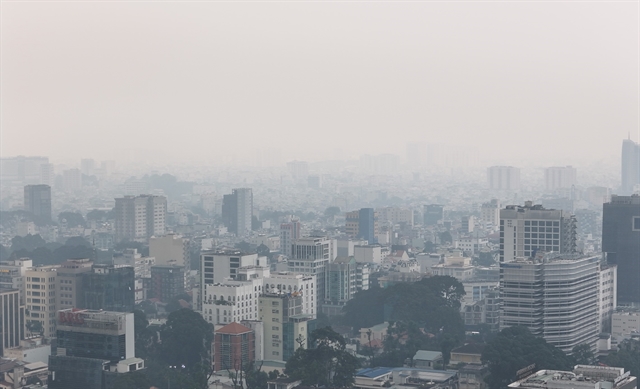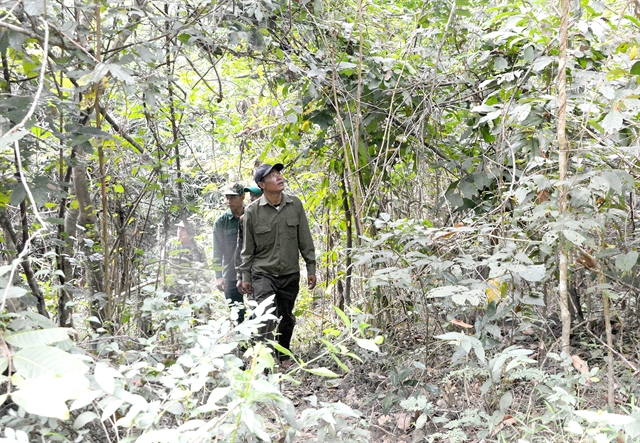 Environment
Environment

 |
| Forest rangers on duty in Ea Sô Nature Reserve in the Central Highlands province of Đắk Lắk.—VNA/VNS Photo Tuấn Anh |
ĐẮK LẮK — Ea Sô Nature Reserve, covering an area of nearly 26,850ha with a diverse ecosystem of precious wood and wild animals, continues to be encroached by local people and threatened by poachers in the Central Highlands province of Đắk Lắk.
The nature reserve has administrative boundaries bordering Krông Pa District in the Central Highlands province of Gia Lai, and Sông Hinh District in the coastal central province of Phú Yên.
Although some hills in Ea Dăh Commune, Krông Năng District in Đắk Lắk Province, belong to the management and protection area of the nature reserve, local people are still growing corn on them.
Đỗ Hải Hoàng, a staff member of the nature reserve’s Forest Ranger Station No 2, said that people living in the areas surrounding the nature reserve were poor and still depend on the forest for their income. This issue has led to their continued encroachment of forest land for farming.
Hoàng said when the dry season came, the people living near the nature reserve often chopped down bamboos and small trees in the nature reserve’s forest.
Lê Minh Tiến, director of the nature reserve’s Management Board of Ea Sô, said there was significant pressure on the board to protect the forest, but the area it had to manage was very large and adjacent to many localities.
According to Tiến, in the area bordering Krông Năng District, forest land encroachment and illegal agricultural cultivation still continued.
Local people were still found illegally logging and hunting wild animals in the nature reserve’s sub-areas No 619, 614 and 632.
The nature reserve discovered and handled 19 cases of Forest Law violations such as illegal forest exploitation, forest land encroachment and violations of general regulations on forest protection in 2023.
The problem of illegal exploitation and transportation of forest products on Highway No 29 running through the nature reserve was ongoing.
The illegally-exploited timbers were mainly rare and endangered species such as sandalwood (Pterocarpus macrocarpus) and makha tree (Afzelia xylocarpa).
Dangerous, arduous job
Poachers are increasingly aggressive. Many poachers fought back against forest management and protection forces with homemade weapons, causing serious injuries to officials and forest rangers over the past time.
Most recently, a serious incident occurred on December 2 when Nguyễn Kim Anh, acting head of the nature reserve’s Forest Ranger Station No 2 inspected an area where local people often deforested and encroached on forest land for farming purposes, adjacent to Giang Đông Village, Ea Dăh Commune, Krông Năng District.
At about 3:00pm on the same day, the authorities discovered Anh dead in a corn field. The preliminary report indicated that he was shot in the abdomen with a home-made shotgun, with 14 bullet wounds. The authorities are investigating and clarifying the case.
Tiến also said the forest management and protection forces had to work in poor living conditions, especially at stations deep in the forest and bordering other provinces.
The remuneration policies for the forest management and protection forces were not commensurate with their tasks and responsibilities, he added.
Therefore, many people working in the forest management and protection forces asked for early retirement or quit their jobs.
This sharply decreased the number of forest protection staff in the nature reserve, posing added challenges for forest management and protection activities.
Additionally, the management board also had to apply a streamlining policy according to rules, he said.
Solutions
Tiến said the management board had conducted more patrols to detect and deal with serious violations, including the case of prosecuting dozens of defendants.
Under his suggestion, in the long term, the nature reserve requested central level agencies, ministries and sectors to issue more-appropriate policies for the forest management and protection forces, because the forces were the units directly maintaining and protecting the forest.
Policies should especially focus on seniority allowance, job allowance and hazard allowance for forest management and protection forces.
The authorised agencies were also asked to consider not to apply the streamlining policy at the nature reserve, because the forest management and protection forces were currently small while their tasks were huge, he said.
The authorised agencies were advised to invest more to help improve the livelihoods of local people in the buffer zone of the nature reserve.
Local authorities in areas bordering the nature reserve should strengthen dissemination so people living in the bordering areas would properly implement forestry policies and regulations, thereby, reducing violations related to forest protection.
The nature reserve has many rare types of wood and 279 species of wild animals, including 69 rare species such as Dhole, golden deer, bison, Sunda flying lemur, gaur and Indochinese serow. — VNS




